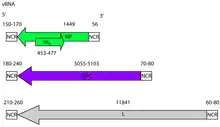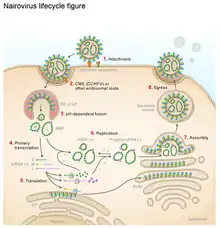Orthonairovirus
Orthonairovirus is a genus of viruses in the family Nairoviridae of the order Bunyavirales that include viruses with circular, negative-sense single stranded RNA.[1] It got its name from the Nairobi sheep disease that affects the gastrointestinal tracts of sheep and goats.[1] The vast majority, and perhaps all viruses in this genus are tick-borne viruses that can have human or other vertebrate hosts.[2]
| Orthonairovirus | |
|---|---|
 | |
| Crimean-Congo hemorrhagic fever orthonairovirus virion and genome | |
| Virus classification | |
| (unranked): | Virus |
| Realm: | Riboviria |
| Kingdom: | Orthornavirae |
| Phylum: | Negarnaviricota |
| Class: | Ellioviricetes |
| Order: | Bunyavirales |
| Family: | Nairoviridae |
| Genus: | Orthonairovirus |
Structure
The virions for viruses in this genus have a spherical shape.[3] They range in size from about 80–120 nm in diameter, with 50% of their weight attributed to proteins and 20–30% of their weight attributed to lipids.[1] The ribonucleocapsid is filamentous, having a length of about 200-300 nm and a width of about 2–2.5 nm.[1] These nucleocapsids are surrounded by a single envelope that has projections made of glycoproteins protruding from its surface. These projections evenly cover the surface of the virion, and are about 5–10 nm long.[1] They aid in attachment to the host receptor in replication.
Genome

Nairovirus genomes are negative sense, single-stranded RNA. The complete genome is about 17,100–22,800 nucleotides long, and is divided into three segments: large, medium, and small.[2] The large segment is about 11000–14400 nucleotides long (11–14.4 kb), and it encodes the viral polymerase.[1][3] The medium segment is about 4,400–6,300 nucleotides long (4.4–6.3 kb), and it encodes for glycoproteins G¬n and Gc.[1][3] The small segment is about 1,700–2,100 nucleotides long (1.7–2.1 kb), and it encodes the nucleocapsid protein.[2]<[1][3]
The genome has terminally redundant sequences, with the sequences being repeated at both ends. The terminal nucleotides are base-paired forming, non-covalently closed, circular RNA.[1] Both the 5’ and 3’ ends have conserved regions, 9 nucleotides in length. The sequences are, 5’end: UCUCAAAGA, and 3’end: AGAGUUUCU.[1]
Replication

Nairoviruses attach to the host receptor by their Gn-Gc glycoprotein dimer.[3] The virus is then endocytosed into the host cell via a vesicle. The ribonucleocapsid segments are released into the cytoplasm, commencing transcription.[3] Transcription and replication occur within the cell, and the newly synthesized virions are released by budding.
Transmission and distribution
Members of this viral genus infect many different vertebrate hosts, and are transmitted via ticks.[1]
Members of the genus Nairovirus may be found the world over, wherever their arthropod vectors and vertebrate hosts are found together.[3]
Clinical importance
Only four viruses in this genus have, to date, been recognised as human pathogens:
A fifth— Erve virus —may also be pathogenic for humans.
Evolution
Phylogenetic analysis has shown that these viruses fall into two major monophyletic groups, the hard (Ixodidae) and soft (Argasidae) tick-vectored groups.[4] Fossil and phylogenetic data places the hard tick-soft tick divergence between 120 million years ago and 92 million years ago. This suggests that the Nairoviruses have been associated with these ticks for over 100 million years.
Additionally, nairoviruses vectored by ticks of the genera Argas, Carios and Ornithodoros form three separate monophyletic lineages, again supporting the suggestion of host-virus cospeciation.
The hard bodied tick serogroups are
- Crimean-Congo hemorrhagic fever
- Nairobi sheep disease
- Sakhalin
- Tamdy
The soft bodied tick serogroups are
- Hughes
- Dera Ghazi Khan
- Qalyub
The tick vectors for the Kasokero and Thiafora serogroups are not currently known.
Taxonomy
The genus includes 41 species:[5]
- Abu Hammad orthonairovirus
- Abu Mina orthonairovirus
- Artashat orthonairovirus
- Avalon orthonairovirus
- Bandia orthonairovirus
- Burana orthonairovirus
- Chim orthonairovirus
- Congoid orthonairovirus
- Crimean-Congo hemorrhagic fever orthonairovirus
- Dera Ghazi Khan orthonairovirus
- Dugbe orthonairovirus
- Erve orthonairovirus
- Estero Real orthonairovirus
- Gossas orthonairovirus
- Hazara orthonairovirus
- Huangpi orthonairovirus
- Hughes orthonairovirus
- Issyk-kul orthonairovirus
- Kasokero orthonairovirus
- Keterah orthonairovirus
- Kupe orthonairovirus
- Leopards Hill orthonairovirus
- Meram orthonairovirus
- Nairobi sheep disease orthonairovirus
- Pacific Coast orthonairovirus
- Punta orthonairovirus
- Qalyub orthonairovirus
- Sakhalin orthonairovirus
- Sapphire orthonairovirus
- Scot orthonairovirus
- Soldado orthonairovirus
- Tacheng orthonairovirus
- Taggert orthonairovirus
- Tamdy orthonairovirus
- Thiafora orthonairovirus
- Tofla orthonairovirus
- Tunis orthonairovirus
- Vinegar Hill orthonairovirus
- Wenzhou orthonairovirus
- Yogue orthonairovirus
- Zirqa orthonairovirus
See also
- Farallon virus
- Meihua Mountain orthonairovirus
- Puffin Island virus
- Yezo orthonairovirus
References
- "ICTV Report Nairoviridae".
- Crabtree, Mary B., Rosemary Sang, and Barry R. Miller. "Kupe Virus, a New Virus in the Family Bunyaviridae, Genus Nairovirus, Kenya." Emerging Infectious Diseases 15 (2009): 147–54.
- "Nairovirus." Nairovirus. Viral Zone. <http://www.expasy.ch/viralzone/all_by_species/251.html>.
- Honig JE, Osborne JC, Nichol ST (2004) The high genetic variation of viruses of the genus Nairovirus reflects the diversity of their predominant tick hosts. Virology 318(1):10-16
- "Virus Taxonomy: 2020 Release". International Committee on Taxonomy of Viruses (ICTV). March 2021. Retrieved 19 May 2021.